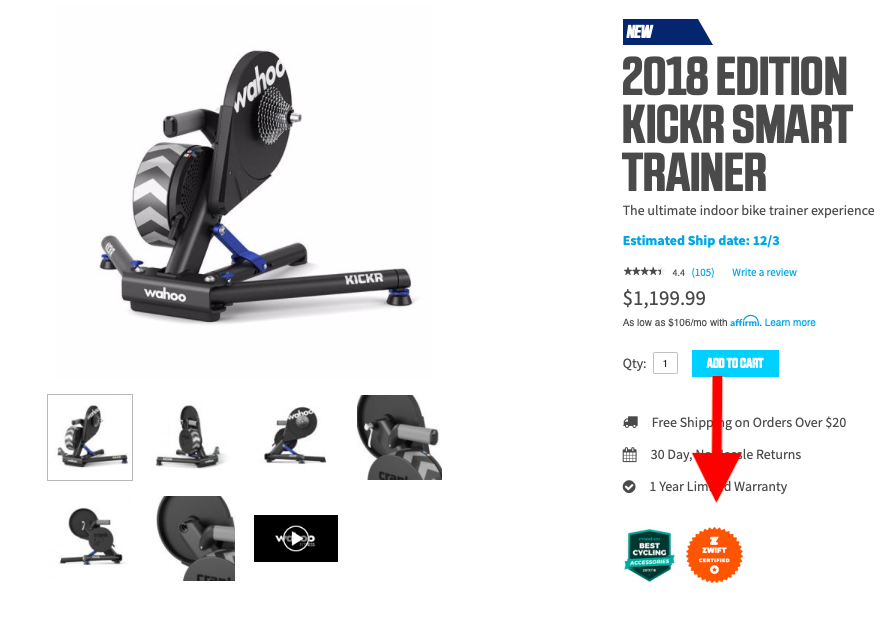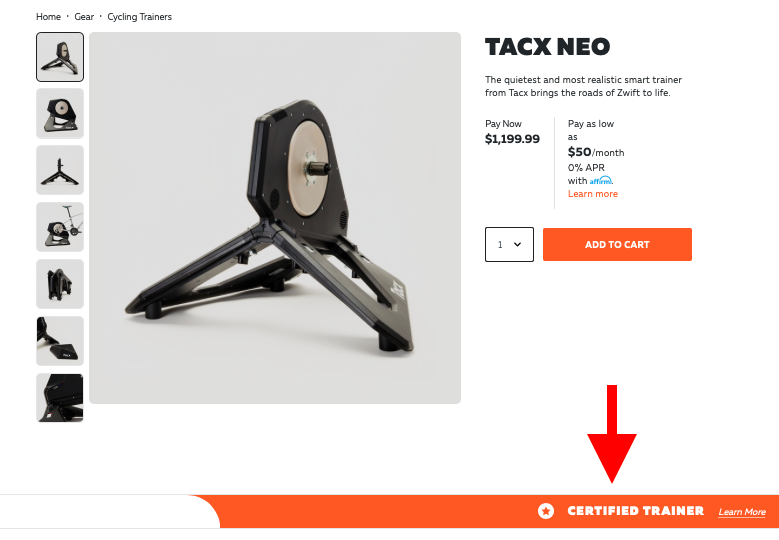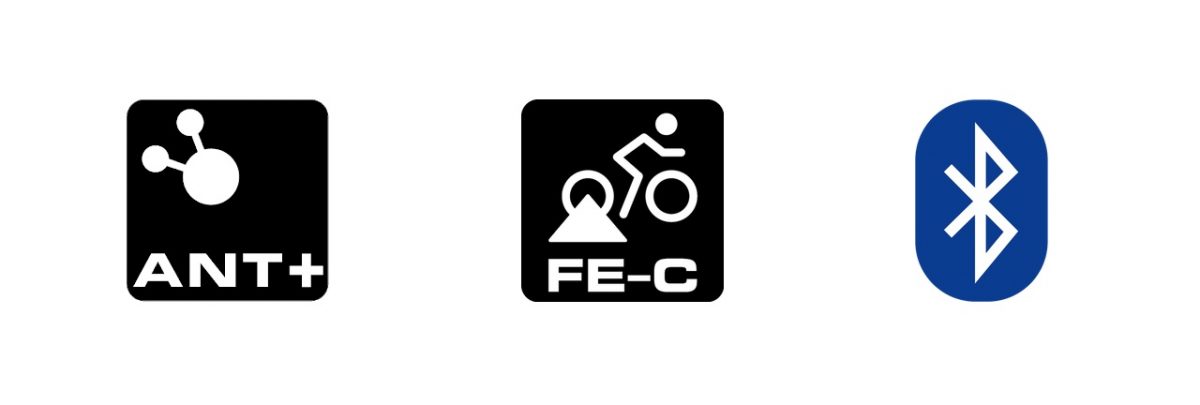If you’ve been shopping for a smart trainer, you’ve probably seen some with a Zwift Certified seal on them. This new seal is Zwift’s attempt to identify trainers that are fully compatible with Zwift and offer users with the “best Zwift experience”

The program was launched by Zwift a few months ago and a number of trainers have been awarded this seal.
Zwift Certified is our qualification mark awarded to smart trainers that meet or exceed the highest standards of quality. The gold standard in cycling equipment, Zwift Certified ensures you’ll have a great ride experience.
Zwift supports a large number of trainers regardless if the trainer is smart or not. As long as you have a power meter or a speed sensor, you can use the trainer with Zwift.
However, smart trainers, offer a more immersive experience with their ability to vary resistance and measure the rider’s power. With a smart trainer, you can simulate a course profile, use workout mode or ERG mode, and take advantage of other supported features in Zwift. The Zwift Certified seal is a way to identify these trainers and hope to make it easy for anyone shopping for a new trainer to know they are getting a smart trainer that will give them the best experience with Zwift.
Here is an example of Wahoo using the Zwift Certified seal on their website.
 Here is Zwift using the Certified seal on their new shopping website.
Here is Zwift using the Certified seal on their new shopping website. 
CERTIFICATION CRITERIA
Zwift tests each trainer model before providing the certification seal for power accuracy, any delay in resistance changes and connections protocols. According to Zwift, for a trainer to be certified, it has to meet the following:
- Broadcasts power data over Bluetooth
- Accuracy within +/- 3%
- Automatically changes resistance
- ERG mode supported
- Spindown for wheel-on trainers (non-direct drive)
WHAT ABOUT ANT+?
ANT+ is the wireless technology that allows devices to talk to each other. In the smart trainer world, this is the communication used between your trainer and other devices such as your bike computer, Windows PC or Mac. In its early years, companies developed their own protocols for controlling trainers and software developers had to implement these protocols for each trainer. Every time, companies introduced a new trainer or decided to make changes to their ANT+ protocols, developers had to recode for it. Then FE-C was developed to standardize these protocols so companies and app developers can easily develop for it and was quickly adopted by trainer companies and software developers.
 Interestingly, Zwift certification criteria don’t list ANT+ anywhere in the certification requirement. Until recently, Zwift didn’t support Bluetooth connection on Windows and just rolled out native BLE support on Windows devices in their latest update. It’s still in beta and only available on up-to-date Windows 10 devices that have Bluetooth 4 support.
Interestingly, Zwift certification criteria don’t list ANT+ anywhere in the certification requirement. Until recently, Zwift didn’t support Bluetooth connection on Windows and just rolled out native BLE support on Windows devices in their latest update. It’s still in beta and only available on up-to-date Windows 10 devices that have Bluetooth 4 support.
Just last year, Technogym was heavily criticized by some reviewers (Shane Miller, and myself) for not including ANT+ FE-C in their MyCycling trainer and their most recent SKILL BIKE. DC Rainmaker published an article earlier this year on what is considered a “baseline” on new smart trainers where he says:
Look, if you’re a trainer company and can’t figure this out [ANT+ FE-C implentation] there are plenty of avenues to get assistance (many of them free). You can go to ANT+ themselves and they’ll help you out. You can go to the leading app companies out there like TrainerRoad and Zwift, and they’ll often help you out
DO WE REALLY NEED ANT+?
I do understand Zwift position on this. Zwift currently runs on the following devices:
- iOS devices: iPhone and iPad (Bluetooth only)
- Apple TV (Bluetooth Only)
- Android (Bluetooth, some support ANT+)
- Mac OS (Built-in Bluetooth. Can use ANT+ with an ANT+ USB key)
- Windows 10 (Built-in Bluetooth. Can use ANT+ with an ANT+ USB key). Devices run older Windows OS can only use ANT+.
All of those devices support Bluetooth only with the exception of Mac OS and Windows. Both natively support Bluetooth and if you want to add ANT+ you have to add an ANT+ key that you have to purchase separately and connect to your computer using a USB port.
There are also some advantages to using Bluetooth. Bluetooth has a longer range and utilizes frequency-hobbing to avoid interference problems. Signal drop-outs caused by interference from other devices is a very common issue when using ANT+ and you will hear Zwifters complain about it ALL .THE. TIME.
The interesting part is, ANT+ FE-C is not that old. It was implemented by most companies in early 2015. That’s just a little over three years ago.
BLUETOOTH FTMS
Bluetooth is widely available on almost every mobile device and computer these days. So it was a no brainer for trainer companies and app developers to support it. But just like ANT+ in its early days, there were no standard Bluetooth protocols to control smart trainers. This was a nightmare for app developers who wanted to provide support for a specific trainer brand. Rather than having one set of code, they essentially had to program for each trainer separately.
Zwift has been the only company that supported Bluetooth for most smart trainers available in the market. TrainerRoad, The Sufferfest, and other indoor cycling apps were very slow to add support for new trainers.
However, this is now changing with Bluetooth FTMS (Fitness Machine Service). It’s the new Bluetooth standard protocol for software to control fitness equipment. App developers and trainer companies are quickly adopting it.
Zwift rolled out Bluetooth FTMS support for running and cycling a few months ago and is now the standard for all new connections across the board. The Sufferfest and TrainerRoad already support FTMS protocols and will work with any FTMS supported trainer.
FINAL THOUGHTS
This doesn’t mean, Zwift and major trainer manufacturers (Wahoo, Tacx, Elite, CycleOps) will stop supporting ANT+, and I don’t see this happening anytime soon. But we can’t ignore the fact that Zwift does have a big clout on this industry and without a doubt, anything Zwift does could have some impact on how companies move forward with new products.
ANT+ does have some advantages and has been the standard for almost all serious fitness devices such as power meters, heart rate monitors, bike computers, etc. However, all these “serious” fitness devices, now also support Bluetooth. Bike computers such as Garmin Edge, Wahoo ELEMNT and Bolt all support controlling smart trainers using ANT+ FE-C.
But since Bluetooth FTMS is now available, it’s very likely to see all devices that currently rely on ANT+ FE-C to adopt Bluetooth FTMS in the next year or so. And, if a company can’t figure out ANT+ FE-C or just trying to cut costs, then it is much easier to drop ANT+ support from their devices now than it was just a year ago.
Thanks for reading!









I use an ANT+ key with an extension USB cord and have been fortunate to never run into any connection issues. Will FTMS help over come the multiple devices connection limit Bluetooth has?
No, FTMS won’t help with that. I believe Bluetooth 5 has the ability to broadcast to multiple audio devices but not sure if this can be implemented on other devices.